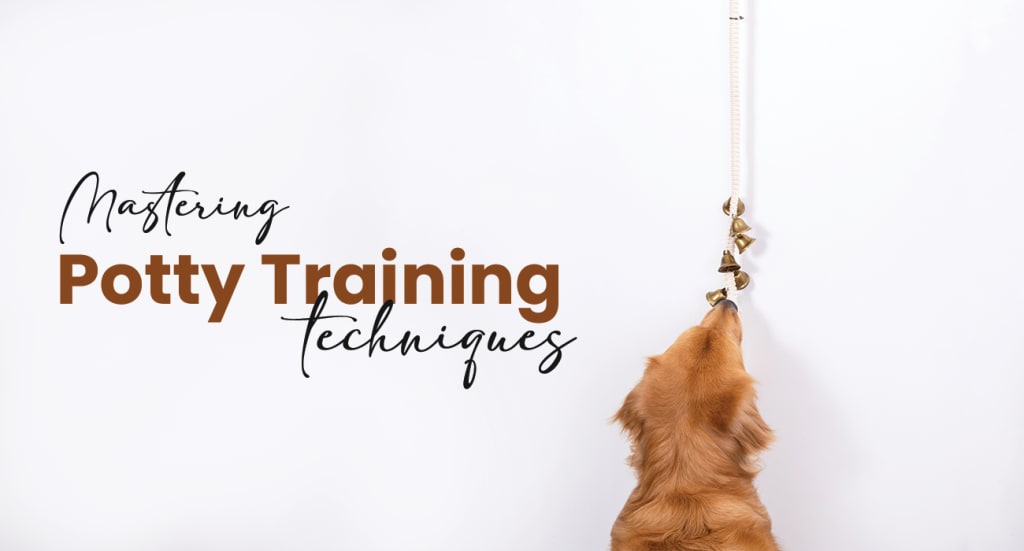Step-by-Step Guide To Using Potty Training Bells For Dogs
Best Potty Training Bells For Dogs | How To Use Them

Training your dog can be one of the most rewarding parts of being a pet parent. It's all about strengthening that special bond with your furry friend and making sure they grow up to be well-mannered and happy. Whether you’re teaching them to ‘sit’ and ‘stay’ or tackling more advanced tricks, it’s all about communication.
Now, what if I told you there’s a way for your dog to communicate with you even better, especially when it comes to those crucial bathroom breaks? Say hello to potty training bells! These little gadgets can totally transform the way you toilet-train your pup. It doesn’t matter if you have a sensitive adult dog or an energetic puppy—training bells can make the whole process smoother and way more effective. Whether you’re looking for training bells for sensitive dogs or toilet training bells for puppies, we’ve got you covered. Ready to dive in? Let’s explore this step-by-step guide to help your dog become a bathroom break pro!
Why Use Potty Training Bells?
Potty training bells offer a clear and consistent way for your dog to signal when they need to go outside. They reduce the chances of indoor accidents and make the potty training process smoother. Plus, they’re fun and engaging for your dog!
Step 1: Choosing The Right Bells
First things first, you need to choose the best potty training bells for your dog. There are various options available, so let’s break it down:
For Sensitive Dogs
Potty training bells for sensitive dogs should be gentle and not too loud. Look for bells with a soft chime that won’t startle your dog.
For Puppies
Toilet training bells for puppies need to be easy to reach and simple to use. Adjustable straps and larger bells can make it easier for tiny paws.
Best Potty Training Bells
The best potty training bells are durable, adjustable, and have a pleasant sound. Consider your dog’s size, age, and temperament when choosing.
Where to Buy
You can find potty training bells for sale at pet stores, online retailers, and even make your own DIY version. Look for high-quality materials and positive reviews.
Step 2: Introducing The Bells
Now that you’ve got your bells, it’s time to introduce them to your dog. Here’s how to make the introduction smooth and stress-free.
Familiarization
Show the bells to your dog. Let them sniff and investigate. Praise them for any interaction with the bells.
Ring the Bells
Every time you take your dog outside to potty, ring the bells yourself. This helps your dog associate the sound with going outside.
Positive Reinforcement
Use treats and praise to encourage your dog to interact with the bells. When they touch or nudge the bells, give them a treat and lots of praise.
Step 3: Training Sessions
Consistency is key when it comes to training your dog to use potty training bells. Here’s a structured approach to get you started.
Regular Intervals
Take your dog to the bells at regular intervals throughout the day—after meals, naps, and playtime. Ring the bells each time and then take them outside.
Encouragement
Encourage your dog to ring the bells themselves. Gently guide their paw or nose to the bells and praise them when they make a sound.
Immediate Action
As soon as the bells ring, take your dog outside immediately. This reinforces the connection between ringing the bells and going outside to potty.
Step 4: Reinforcement and Rewards
Positive reinforcement is crucial for successful training. Here’s how to make sure your dog understands and enjoys the process.
Consistent Praise
Every time your dog rings the bells and successfully goes outside to potty, praise them enthusiastically. Make it a big deal!
Treats
Use high-value treats that your dog loves. Keep a stash near the door so you can reward them immediately after they ring the bells.
Patience
Be patient and consistent. Some dogs learn quickly, while others may take a bit longer. Keep the training sessions short and fun to avoid frustration.
Step 5: Troubleshooting Common Issues
Every dog is different, and you might encounter some challenges along the way. Here’s how to troubleshoot common issues.
Ignoring the Bells
If your dog ignores the bells, try using a higher-value treat or a more enticing reward. You can also try ringing the bells more frequently yourself.
Playing with the Bells
Some dogs might think the bells are a toy. If this happens, reward them only when they use the bells appropriately and ignore them when they’re just playing.
Accidents
If accidents happen inside, don’t scold your dog. Instead, reinforce the positive behavior when they do use the bells correctly. Clean up accidents thoroughly to remove any lingering scent.
Step 6: Gradually Reducing the Rewards
Once your dog consistently rings the bells to go outside, you can gradually reduce the frequency of treats and praise.
Random Reinforcement
Start by rewarding your dog randomly instead of every time. This keeps them motivated without constantly relying on treats.
Verbal Praise
Shift to more verbal praise and fewer frequent treats. Your dog should still feel rewarded, but it should not always expect a treat.
Maintenance
Continue to praise your dog for using the bells, even if you’re not giving treats every time. This keeps the behavior strong and consistent.
Additional Tips And Tricks
Here are some extra tips to make the training process even smoother:
Use Multiple Bells
Place bells on different doors if you have multiple exits. This ensures your dog can signal no matter where they are in the house.
Consistent Commands
Use a consistent command like ‘Ring the Bell’ or ‘Potty Time’ when guiding your dog to the bells. This reinforces the behavior and makes it easier for them to understand.
Involve the Whole Family
Make sure everyone in the household is on the same page. Consistent training from all family members helps your dog learn faster.
Conclusion
Training your dog to using the best potty training bells can be a game-changer in your household. With patience, consistency, and lots of positive reinforcement, your dog will soon be ringing the bells like a pro. Whether you have a sensitive dog, a playful puppy, or anything in between, this guide has everything you need to get started.
Remember, the key is to make the process fun and rewarding for your dog. So, grab those bells, start training, and enjoy the benefits of a cleaner, more communicative relationship with your furry friend. Happy training!
About the Creator
Pawsome Pals
Pawsome Pals - The Ultimate Luxury Experience For Best Pet Supplies
At Pawsome Pals, the team understands that fur babies are not just pets, they are family!
Enjoyed the story? Support the Creator.
Subscribe for free to receive all their stories in your feed. You could also pledge your support or give them a one-off tip, letting them know you appreciate their work.






Comments
There are no comments for this story
Be the first to respond and start the conversation.